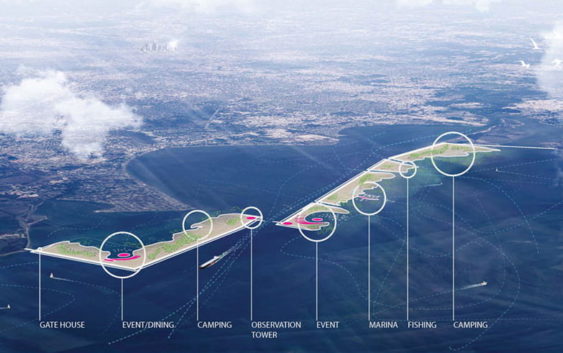- Seven months after Hurricane Helene, Chimney Rock rebuilds with resilience
- Wildfire in New Jersey Pine Barrens expected to grow before it’s contained, officials say
- Storm damage forces recovery efforts in Lancaster, Chester counties
- Evacuation orders lifted as fast-moving New Jersey wildfire burns
- Heartbreak for NC resident as wildfire reduces lifetime home to ashes
Proposal Would Help Protect Houston Area From Hurricanes, Create 10,000-Acre Public Park

Galveston Bay Park would include trails for hiking, biking and horseback riding and designated areas for concerts and large events, camping, fishing, boating, birdwatching and other activities.
A proposal to protect the Houston area from hurricane storm surge is gaining recognition for its innovative design, though project leaders say it still faces obstacles in becoming a reality.
Conceived by Rice University’s SSPEED Center and designed by the architecture firm Rogers Partners, Galveston Bay Park envisions a chain of man-made islands that form a 10,000-acre public park. The islands would be built using dredge material from the Houston Ship Channel, and also serve as a barrier to protect the coast from hurricane storm surge.
“What we want to do is use the material from dredging the channel to build a collection of islands adjacent to the channel,” said Rob Rogers, partner and founder of Rogers Partners. “These would be high enough and robust enough to protect Houston from even the large category 4, category 5 hurricanes, really providing security for the region for decades.”
 Rogers Partners’ design for Galveston Bay Park earned top honors in Houston 2020 Visions, an international design competition launched in the wake of Hurricane Harvey.
Rogers Partners’ design for Galveston Bay Park earned top honors in Houston 2020 Visions, an international design competition launched in the wake of Hurricane Harvey.
Rogers said the islands would have a “hard side” that acts like a dike, and a “soft side” that allows for the development of wetlands and beaches. There would also be several storm surge gates — like those used in the Netherlands — that would allow ships to pass through and be closed in the event of a large storm.
“Imagine riding your bike, riding a horse, camping, installation of marinas, habitat, fisheries — all these things that could be gathered on the collection of islands. We really think about this as a piece of 21st-century infrastructure,” he said.
The project proposal was chosen as one of the top designs in the Houston 2020 Visions competition, which sought creative ideas focused on making Houston more resilient. The designs will be on display in the fall at the Architecture Center Houston.
“It is a way of providing significant flood protection from a hurricane that has a large surge flood, which is a huge risk for our region,” said Jim Blackburn, co-director of Rice’s SSPEED Center. “But it also combines widening of the Ship Channel, environmental enhancement, and recreation. So it’s sort of you get four for the price of one.”
The idea came about after Hurricane Ike, Blackburn said.
“If Ike had gone 30 miles down the coast, we’d still be cleaning up Galveston Bay from the damage Ike would have done up the Ship Channel,” said Blackburn. “We got lucky with Ike, but we cannot depend on luck.”
Blackburn said they used models to examine how future hurricanes could impact the area, and designed Galveston Bay Park to protect the Ship Channel against a 25-foot storm surge, which could be devastating to both the environment and the economy.
“If you get 15-20 foot of surge coming up the channel, we will lose storage tanks,” he said. “Those storage tanks will contaminate the bay. And we could be looking at the end of Galveston Bay as we know it because of the contaminants that could be released.”
 An artist’s illustration of the multiple features of an island in Galveston Bay Park.
An artist’s illustration of the multiple features of an island in Galveston Bay Park.
The project leaders estimate it would cost between $3-6 billion to build, though officials from the Army Corps of Engineers have questioned that price tag. Blackburn said before becoming a reality, they still need to secure funding and carry out additional engineering and environmental studies for the proposal.
He said the next step is to find a local government agency to sponsor the required environmental study by the Army Corps of Engineers — they’ve been in talks with the Port of Houston as well as Harris County, though both have yet to make a formal commitment.
“These are hard projects to find sponsor for; they’re expensive projects. But the risk, the potential damage is so huge. And it is not a long jump to see a truly destructive hurricane coming into the Houston region,” said Blackburn.
For its part, the Army Corps of Engineers has released a statement saying Galveston Bay Park would complement and enhance its $32 billion Coastal Spine Project that is in development.
“We are all working toward the same goal,” Col. Timothy R. Vail, commander of the Galveston District, said in a press release at the time. “The construction of one of the concepts doesn’t preempt the construction of the other.”
Subscribe to Today in Houston
Fill out the form below to subscribe our new daily editorial newsletter from the HPM Newsroom.